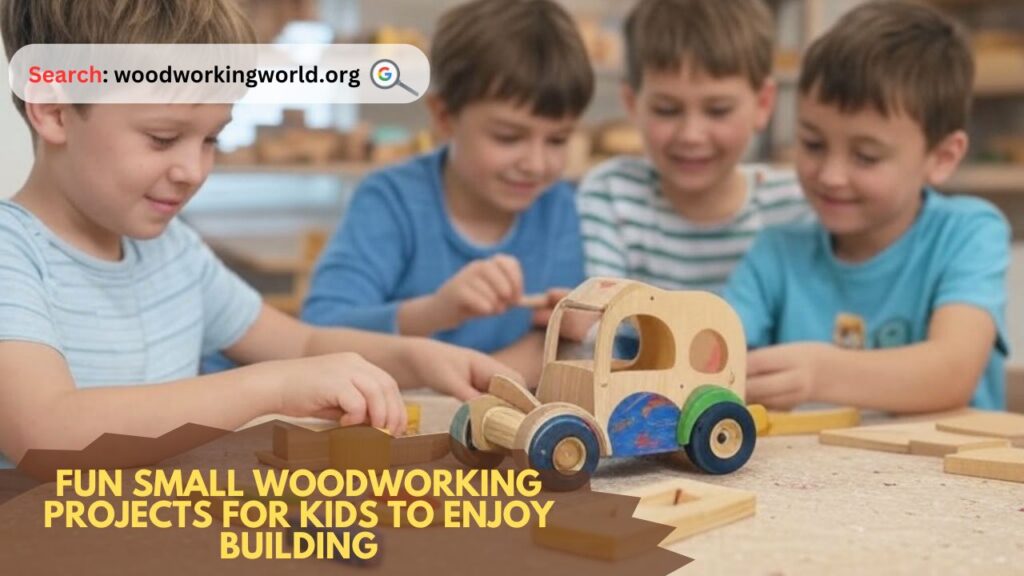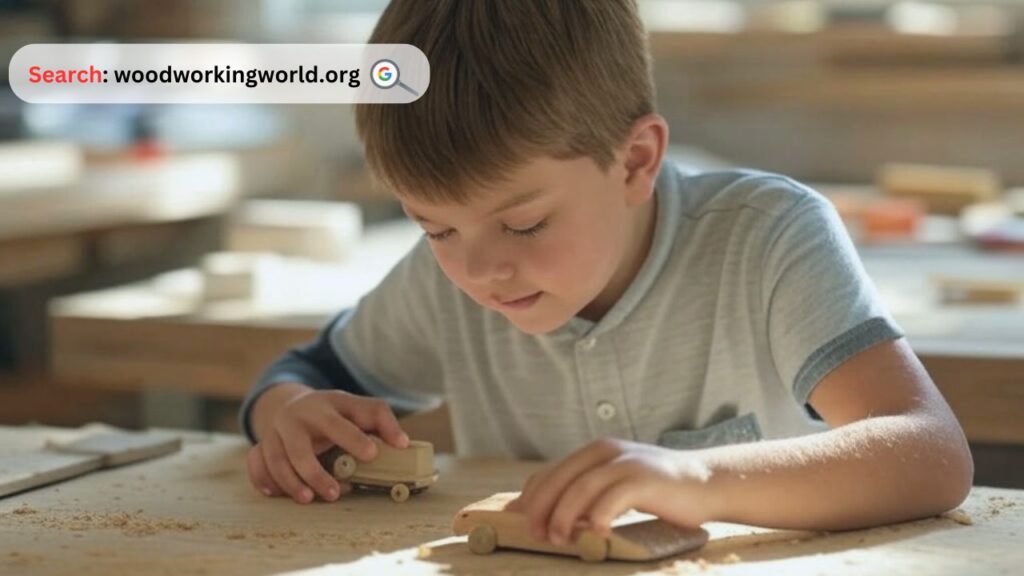Fun and easy small woodworking projects for kids to build! Safe, creative, and beginner-friendly ideas to spark their imagination and hands-on skills.
Woodworking can be a fun, creative, and educational activity for children. Not only does it allow them to engage with their hands, but it also teaches them patience, precision, and problem-solving skills. With the right projects, kids can explore the world of carpentry, develop their fine motor skills, and create something they can be proud of. Whether you’re a parent, grandparent, or teacher, there are plenty of fun, simple woodworking projects that kids will enjoy and learn from.

In this article, we will explore several small woodworking projects for kids, breaking down the materials needed, step-by-step instructions, and offering helpful tips along the way. These projects are designed to be safe, easy to do, and above all—enjoyable for kids of different ages.
Why Woodworking for Kids?
Before diving into the projects, it’s essential to understand why woodworking is such a great activity for children:
- Creativity Boost: Woodworking encourages kids to think outside the box and come up with their own designs.
- Hands-On Learning: Working with real tools and materials helps kids understand how things are made and teaches them cause and effect.
- Improves Focus and Patience: The process of measuring, cutting, and assembling requires kids to focus on the task at hand and practice patience.
- Self-Esteem: Creating something tangible gives kids a sense of accomplishment and boosts their confidence.
Build 16,000+ Projects with Step-by-Step Plans—No Big Workshop or Costly Tools Needed! Start Now!
Top Fun Small Woodworking Projects for Kids
Here are some fantastic woodworking projects that are simple yet exciting for children:
1. Mini Wooden Picture Frame
A mini wooden picture frame is a great project for younger kids, as it involves basic measuring, cutting, and decorating. It’s a perfect way to personalize a space with a family photo, and it also makes for a fun craft for birthdays or holidays.
Materials Needed:
- Small wooden dowels or craft sticks
- Wood glue
- Sandpaper
- Paint or markers
- Small photo (optional)
Step-by-Step Instructions:
- Cut the craft sticks or dowels to the size of the photo you want to frame.
- Lay the pieces out on a flat surface to form a rectangular shape.
- Apply wood glue to the edges of the craft sticks to join them at the corners.
- Let the frame dry for about an hour.
- Once the glue is dry, sand the edges of the frame to make it smooth.
- Decorate with paint, markers, or stickers.
- Insert your photo, and you have a custom, kid-made picture frame!
2. Wooden Bird Feeder
Building a bird feeder is an exciting project that brings children closer to nature. It also provides a sense of responsibility, as kids can monitor the birds that visit their creations.
Materials Needed:
- A small wooden block (approximately 4×4 inches)
- Nails or screws
- Drill with small bit (if using screws)
- Paint or wood stain
- String or wire for hanging
- Bird seed
Step-by-Step Instructions:
- Begin by drilling holes into the wooden block to create a place for the birdseed.
- If necessary, attach the block to a sturdy surface using nails or screws.
- Paint or stain the wooden block to protect it from the elements.
- Attach string or wire to the top for easy hanging.
- Fill with birdseed and hang in a tree or outdoor area.
3. Wooden Coasters
Wooden coasters are both practical and decorative. Kids can create a set of coasters that are both functional and stylish.
Materials Needed:
- Thin wooden slices (from a craft store or tree branches)
- Sandpaper
- Wood stain or paint
- Felt pads (optional)
Step-by-Step Instructions:
- Sand the wooden slices to smooth the surface.
- If desired, paint or stain the coasters for color and protection.
- Once the paint or stain has dried, attach felt pads to the bottom to protect furniture from scratches.
- Let the coasters dry completely before using.
4. Toy Car Ramp
Creating a simple wooden toy car ramp will keep kids entertained for hours. This project is simple to build and perfect for children who love playing with cars.
Materials Needed:
- Wooden planks
- Nails or screws
- Sandpaper
- Toy cars
- Ruler or measuring tape
Step-by-Step Instructions:
- Cut two wooden planks to the desired length of the ramp.
- Attach the two planks to a flat surface at an angle using nails or screws.
- Sand the edges to remove any sharp corners.
- Let the kids race their toy cars down the ramp.
5. Wooden Pencil Holder
This is a simple and practical woodworking project that also helps kids keep their desks organized.
Materials Needed:
- Wooden blocks (small)
- Drill
- Sandpaper
- Paint or markers
Step-by-Step Instructions:
- Sand the edges of the block until smooth.
- Drill a few holes on the top of the block to fit pencils and pens.
- Paint or decorate the pencil holder as desired.
- Allow the paint to dry before using it to hold your writing instruments.
Expert tips on Woodworking 🌿📦 Watch now!

Comparing the Projects
To help you choose the best project for your child, here’s a comparison table outlining the materials, difficulty levels, and time needed for each project:
| Project | Materials | Difficulty | Time to Complete |
|---|---|---|---|
| Mini Wooden Picture Frame | Wooden dowels/craft sticks, glue, paint, photo | Easy | 30 minutes |
| Wooden Bird Feeder | Wood block, nails/screws, paint, string, birdseed | Moderate | 1-2 hours |
| Wooden Coasters | Wooden slices, paint, felt pads | Easy | 1 hour |
| Toy Car Ramp | Wooden planks, nails, toy cars | Moderate | 1-2 hours |
| Wooden Pencil Holder | Wooden block, drill, sandpaper, paint | Easy | 30-45 minutes |
Tips for Successful Woodworking with Kids
- Safety First: Always supervise kids when using tools, especially sharp or power tools. Consider using kid-friendly tools or pre-cut materials for younger children.
- Involve Them in Every Step: Whether it’s measuring, painting, or assembling, let the kids participate in every stage of the project to enhance their learning experience.
- Patience is Key: Woodworking can sometimes be slow, so encourage kids to take their time and be patient with the process.
- Celebrate the Outcome: Display the finished projects proudly. This boosts the child’s confidence and gives them a sense of pride in their work.
A Word from an Expert
As woodworking educator and author Tim Herman once said, “Woodworking is not just about making things; it’s about making better versions of ourselves. Every project offers an opportunity to learn, improve, and create something of value.”
This quote perfectly encapsulates the benefits that woodworking provides, not just in the product, but in the process of building something with your own hands.
FAQ Section
1. At what age can kids start woodworking?
Kids as young as 3-4 years old can begin with simple, supervised woodworking projects like painting or assembling pre-cut pieces. As they grow older, they can gradually take on more complex tasks like using hand tools.
2. What tools are safe for kids to use?
For younger children, consider using non-toxic, child-safe tools. For older kids, small hammers, screwdrivers, and plastic or wooden hand saws are good choices. Always supervise tool usage and ensure the child is properly trained.
3. Can woodworking help kids with schoolwork?
Absolutely! Woodworking can improve spatial reasoning, math skills (through measurements), and creativity. These skills translate well into subjects like geometry, physics, and art.
4. How can I ensure safety while woodworking?
Always supervise your child while they work. Ensure they wear safety gear like goggles and gloves when needed. Work in a well-lit, clean, and clutter-free area.
5. What should I do if my child loses interest in a project?
If a child becomes bored or frustrated, take a break or try a simpler task. Sometimes a project may need to be broken down into smaller steps, and it’s important to celebrate small victories to maintain interest.

Conclusion
Woodworking is a fantastic, hands-on activity for children, combining creativity with practical skills. These small projects are a great introduction to the craft, helping children develop fine motor skills, patience, and confidence. Whether it’s creating a wooden picture frame or building a toy car ramp, kids can enjoy learning while making something they can proudly display.
By starting with simple projects and gradually increasing the complexity, you’ll not only keep kids engaged but also help them build a lifelong appreciation for crafting.
Click To Order Teds Woodworking With A 60-Money-back Guarantee From – Official Website